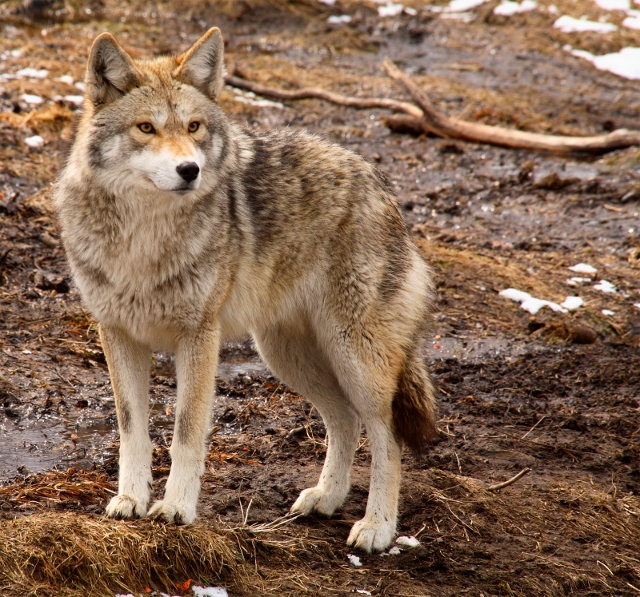saveourplanetearth.com
Call us: (775) 831-1331
Learning to Love the Wily Coyote
Many people look upon the coyote as a menace or a pest—certainly farmers whose livestock they raid and pet owners whose pet has been carried off by an opportunistic coyote.
The howling of the coyote is an eerie sound, often accompanied by a series of yips, yet the howl is but one of at least 11 different sounds falling into three categories: alarm, greeting and contact. The group yip howl, the one we hear so often in the distance, is conducted when two or more members of a pack reunite after a period apart.
• Coyotes are present throughout the North American continent from Alaska down through Mexico and into Panama in South America
Coyotes are present throughout the North American continent from Alaska down through Mexico and into Panama in South America
• …predominantly eat meat with 90% of its diet composed of animal matter, but will also eat fruits and grasses
…predominantly eat meat with 90% of its diet composed of animal matter, but will also eat fruits and grasses
• …hunt small prey alone, such as mice and squirrels but will cooperate in pairs or small groups to take down larger prey
…hunt small prey alone, such as mice and squirrels but will cooperate in pairs or small groups to take down larger prey
Coyotes will hunt cooperatively with badgers, snatching prairie dogs, squirrels and moles from their dens. The coyote locates the prey underground by scent or by chasing it into its lair. The badger digs while the coyote remains alert in case the prey escapes from another exit.
These two animals have even shown playful and affectionate behavior towards one another. Badger-coyote hunting pairs are so effective, researchers have the seen the same two hunting together repeatedly.
A much-repeated urban legend has it that the coyote will send out a lone scout to lure pets away from the safety of their homes and into the jaws of a waiting pack—a tale sprung from the tendency for dogs to give chase to a lone coyote, who naturally runs toward the safety of its pack.
One morning in early spring, I was walking my usual route with my Golden Retriever, along with maybe 5 or 6 other dogs in my care and suddenly my dog began doing her coyote dance. She picked up the scent and up the hill she went, followed by my entire pack of dogs except one, who listened to my demands to “get back here right now.”
It was perhaps just a few minutes that felt like forever when I saw one of my dogs racing back down the hill, with a coyote hot on his heels. Everyone made it back but that coyote and its mate stalked us most every day and night after that for the next month. They must have had a den up the hill and made sure to let my dogs know to keep away.
Eventually the pair left the area and I never saw them again. In fact, since then, and it’s been two or three years, I haven’t had a problem at all with coyotes on my walk with the dogs. I like to think this pair spread the word that my pack was too much to contend with.
People love to hate coyotes, even staging coyote hunting “contests” with prizes or money to the hunter who kills the most. Fortunately, these people are balanced by some wildlife angels who work to protect them.
I discovered the story of an 86-year-old retired school teacher, who while on her usual walk near the grounds of the Pebblebrook Golf Course in Arizona, came across a coyote pup covered in cholla cactus spines and obviously in agony. This kind woman was moved to tears, followed the pup and was able to gain the attention of a couple of golf course maintenance workers.
One of the men held the pup down (wearing heavy gloves) and the other, using giant pliers, plucked out every last spine, including some from his mouth. The pup’s coyote family was nearby so they were able to reunite the pup with the mother and four siblings, who had been watching the process without interfering.
There are people who love coyotes and work to rescue them such as the Indiana Coyote Rescue Center (ICRC) in Burlington, Indiana. The ICRC was founded in 1989 by the late Cecilia Lambert who had been volunteering at the Wolf Park rehabilitation and rescue facility in Battle Ground, Indiana.
Cecilia became interested in coyotes when the wolf facility received two coyote pups. The director and founder of the Wolf Park gave her a book written by Hope Ryden, who had spent years observing coyotes in Yellowstone National Park, called “God’s Dog: A Celebration of the North American Coyote”.
Cecilia realized she wanted to give the coyote a chance to be understood on a higher level than it was currently known and she dedicated the remainder of her life to the foundation she initially ran with her personal funds and donations from a small donor base.
Coyotes will snatch a pet, given the opportunity, but coyotes do their part in nature by keeping the rodent population down. Be diligent with small pets and learn to appreciate the craftiness of the wily coyote that can cozy up to a badger, no less.



